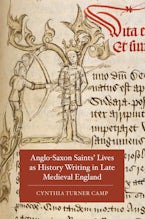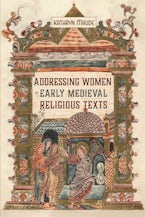
Title Details
297 Pages
23.4 x 15.6 cm
3 b/w illus.
Series: Gender in the Middle Ages
Series Vol. Number:
17
Imprint: D.S.Brewer
Holy Harlots in Medieval English Religious Literature
Authority, Exemplarity and Femininity
- Description
- Contents
- Author
- Reviews
First comprehensive investigation of the major significance of female sinners turned saints in medieval literature.
During the Middle Ages, the lives of saints such as Mary Magdalen and Mary of Egypt - "holy harlots", women who repented of an early life of licentiousness to become blessed - were hugely popular, for both clerical and laypersons, men and women alike. These legends are rife with paradox: the saints are presented as epitomes of a type of femininity universally accepted as a model for all Christians to emulate in their quest for salvation, but at the same time they constitute marginal figures who could be petitioned in support of unconventional beliefs and lifestyles. The holy harlot's potential to contain the markers of both sainthood and whoredom within a single female body was however rejected in the sixteenth century, and so this fascinating model of sanctity has since been largely overlooked.
This book, the first full-length study on the topic, aims to redress the situation, demonstrating that the seapparent outliers transformed mainstream concepts of piety and womanhood. It uses the Old English Martyrology and the Old English Life of Mary of Egypt to show that the early English conceived harlots becoming saints as a move from female to queer rather than as a gender inversion. In the later Middle Ages, "holy harlot" lives in the French of England and in Middle English (including the South English Legendary, the Digby Mary Magdalene, and in lives by John Mirk and Osbern Bokenham) are shown to demonstrate the centrality, from the twelfth-century rise of affective piety, of the harlot saints' femininity as a model for Everyman. They can also be seen as an influence on the writings of such women as Christina of Markyate, Margery Kempe, and Elizabeth Barton, and key to the self-representation of Bernard of Clairvaux and the Wycliffites.
During the Middle Ages, the lives of saints such as Mary Magdalen and Mary of Egypt - "holy harlots", women who repented of an early life of licentiousness to become blessed - were hugely popular, for both clerical and laypersons, men and women alike. These legends are rife with paradox: the saints are presented as epitomes of a type of femininity universally accepted as a model for all Christians to emulate in their quest for salvation, but at the same time they constitute marginal figures who could be petitioned in support of unconventional beliefs and lifestyles. The holy harlot's potential to contain the markers of both sainthood and whoredom within a single female body was however rejected in the sixteenth century, and so this fascinating model of sanctity has since been largely overlooked.
This book, the first full-length study on the topic, aims to redress the situation, demonstrating that the seapparent outliers transformed mainstream concepts of piety and womanhood. It uses the Old English Martyrology and the Old English Life of Mary of Egypt to show that the early English conceived harlots becoming saints as a move from female to queer rather than as a gender inversion. In the later Middle Ages, "holy harlot" lives in the French of England and in Middle English (including the South English Legendary, the Digby Mary Magdalene, and in lives by John Mirk and Osbern Bokenham) are shown to demonstrate the centrality, from the twelfth-century rise of affective piety, of the harlot saints' femininity as a model for Everyman. They can also be seen as an influence on the writings of such women as Christina of Markyate, Margery Kempe, and Elizabeth Barton, and key to the self-representation of Bernard of Clairvaux and the Wycliffites.
Introduction
Chapter 1: "Seo wæs ærest synnecge": The Holy Harlot's Transformations in Old English Hagiography
Chapter 2: The Post-Conquest Harlot: Affective Piety and the Romance Genre
Chapter 3: Heterodoxy, Patronage, and the Harlot in 14th and 15th Century Hagiography
Chapter 4: "She shal byn abyll to dystroye helle": Gender and Authority in the Digby Mary Magdalene/
Chapter 5: Admiranda et Imitanda?/ Emulation of the Holy Harlot Type by Late Medieval Female Mystics
Conclusion: Holy or Harlot? The Early Modern Demise of the Saintly Prostitute
Appendix: Vernacular Lives of Holy Harlots in Medieval Insular Hagiography
Bibliography
Chapter 1: "Seo wæs ærest synnecge": The Holy Harlot's Transformations in Old English Hagiography
Chapter 2: The Post-Conquest Harlot: Affective Piety and the Romance Genre
Chapter 3: Heterodoxy, Patronage, and the Harlot in 14th and 15th Century Hagiography
Chapter 4: "She shal byn abyll to dystroye helle": Gender and Authority in the Digby Mary Magdalene/
Chapter 5: Admiranda et Imitanda?/ Emulation of the Holy Harlot Type by Late Medieval Female Mystics
Conclusion: Holy or Harlot? The Early Modern Demise of the Saintly Prostitute
Appendix: Vernacular Lives of Holy Harlots in Medieval Insular Hagiography
Bibliography
"[S]uperb. [...] Vuille's book is thoroughly researched, cogently argued, and beautifully written. I recommend it to anyone interested in religion and gender in the medieval period." MEDIUM AEVUM
Hardcover
9781843845898
April 2021
£75.00 / $115.00
Ebook (EPDF)
9781800101203
April 2021
$29.95 / £24.99
Ebook (EPUB)
9781800101210
April 2021
$29.95 / £24.99
Title Details
297 Pages
2.34 x 1.56 cm
3 b/w illus.
Series: Gender in the Middle Ages
Series Vol. Number:
17
Imprint: D.S.Brewer














